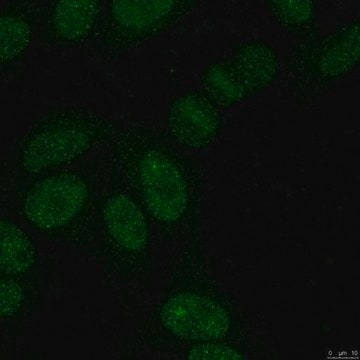MABS2071
Anti-SUMO-1 Antibody, clone 21C7
clone 21C7, from mouse
Synonyme(s) :
Small ubiquitin-related modifier 1, GAP-modifying protein 1, GMP1, SMT3 homolog 3, Sentrin, Ubiquitin-homology domain protein PIC1, Ubiquitin-like protein SMT3C, Smt3C, Ubiquitin-like protein UBL1
About This Item
Produits recommandés
Source biologique
mouse
Forme d'anticorps
purified immunoglobulin
Type de produit anticorps
primary antibodies
Clone
21C7, monoclonal
Espèces réactives
chicken, human, mouse, zebrafish, rat, Xenopus, fish
Conditionnement
antibody small pack of 25 μg
Technique(s)
immunocytochemistry: suitable
immunofluorescence: suitable
immunohistochemistry: suitable
immunoprecipitation (IP): suitable
western blot: suitable
Isotype
IgG2b
Numéro d'accès NCBI
Numéro d'accès UniProt
Modification post-traductionnelle de la cible
unmodified
Informations sur le gène
human ... SUMO1(7341)
Description générale
Spécificité
Immunogène
Application
Immunocytochemistry Analysis: A representative lot detected SUMO-1 in Immunocytochemistry applications (Matunis, M.J., et. al. (1996). J Cell Biol. 135(6 Pt 1):1457-70; Zhang, X.D., et. al. (2008). Mol Cell. 29(6):729-41).
Immunoprecipitation Analysis: A representative lot immunopprecipitated SUMO-1 in Immunoprecipitation applications (Costa, M.W., et. al. (2011). PLoA One. 6(9):e24812; Becker, J., et. al. (2013). Nat Struct Mol Biol. 20(4):525-31; Girach, F., et. al. (2013). Cell Rep. 5(5):1294-301; Chanda, A., et. al. (2017). PLoS One. 12(5):e0177639).
Western Blotting Analysis: A representative lot detected SUMO-1 in Western Blotting applications (Zhang, X.D., et. al. (2008). Mol Cell. 29(6):729-41; Matunis, M.J., et. al. (1996). J Cell Biol. 135(6 Pt 1):1457-70; Rogers, R.S., et. al. (2004). Chromosoma. 113(5):233-43; Costa, M.W., et. al. (2011). PLoA One. 6(9):e24812; Becker, J., et. al. (2013). Nat Struct Mol Biol. 20(4):525-31).
Immunofluorescence Analysis: A representative lot detected SUMO-1 in Immunofluorescence applications (Girach, F., et. al. (2013). Cell Rep. 5(5):1294-301; Rogers, R.S., et. al. (2004). Chromosoma. 113(5):233-43; Matunis, M.J., et. al. (1996). J Cell Biol. 135(6 Pt 1):1457-70).
Signaling
Qualité
Western Blotting Analysis: 4 µg/mL of this antibody detected SUMO-1 in HCT116 cell lysate.
Description de la cible
Forme physique
Stockage et stabilité
Autres remarques
Clause de non-responsabilité
Not finding the right product?
Try our Outil de sélection de produits.
Certificats d'analyse (COA)
Recherchez un Certificats d'analyse (COA) en saisissant le numéro de lot du produit. Les numéros de lot figurent sur l'étiquette du produit après les mots "Lot" ou "Batch".
Déjà en possession de ce produit ?
Retrouvez la documentation relative aux produits que vous avez récemment achetés dans la Bibliothèque de documents.
Notre équipe de scientifiques dispose d'une expérience dans tous les secteurs de la recherche, notamment en sciences de la vie, science des matériaux, synthèse chimique, chromatographie, analyse et dans de nombreux autres domaines..
Contacter notre Service technique








